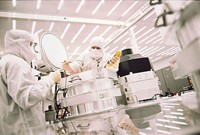Advertisement
Grab your lab coat. Let's get started
Welcome!
Welcome!
Create an account below to get 6 C&EN articles per month, receive newsletters and more - all free.
It seems this is your first time logging in online. Please enter the following information to continue.
As an ACS member you automatically get access to this site. All we need is few more details to create your reading experience.
Not you? Sign in with a different account.
Not you? Sign in with a different account.
ERROR 1
ERROR 1
ERROR 2
ERROR 2
ERROR 2
ERROR 2
ERROR 2
Password and Confirm password must match.
If you have an ACS member number, please enter it here so we can link this account to your membership. (optional)
ERROR 2
ACS values your privacy. By submitting your information, you are gaining access to C&EN and subscribing to our weekly newsletter. We use the information you provide to make your reading experience better, and we will never sell your data to third party members.
Electronic Materials
Chipmaker TSMC is set back by a bad photoresist
Problem with key material halts a production line
by Michael McCoy
February 7, 2019
| A version of this story appeared in
Volume 97, Issue 6

A production outage at a semiconductor maker is providing a window into the computer chip industry’s dependence on its suppliers of high-purity materials—and what can happen when something goes wrong with those chemicals.
Taiwan Semiconductor Manufacturing Company (TSMC), the world’s largest contract chipmaker, disclosed to investors late last month that it had to halt one of its production lines in Taiwan after it discovered subpar devices. TSMC traced the problem to a bad batch of photoresist, the light-developable polymer used to create circuit lines, from one of its main suppliers.
Industry sources say the firm’s key photoresist suppliers are Dow Chemical, JSR, and Shin-Etsu Chemical.
The production line was making chips with 12 and 16 nm circuitry, one of the firm’s more advanced technologies. TSMC says it expects to make up for the loss in the coming months.
The core photopolymers used to create 12 and 16 nm circuit lines are typically acrylics based on three or four coreacted monomers, according to Mark Thirsk, an analyst with the electronic materials advisory firm Linx Consulting. The polymers are chemically amplified to boost the development process. The formula also contains quenchers, surfactants, solvents, and photoacid generators, which aid in the chemical amplification.
“The spec sheets for these sort of photoresists are horrendously complicated,” Thirsk says.
He speculates that TSMC’s problem was caused not by a contaminant but by some almost-undetectable variation in a photoresist component. “It could be the effect was so subtle that it got through all the quality testing,” Thirsk says.



Join the conversation
Contact the reporter
Submit a Letter to the Editor for publication
Engage with us on Twitter